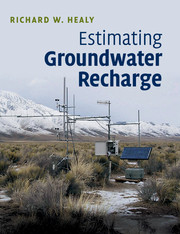Book contents
- Frontmatter
- Contents
- Preface
- Acknowledgments
- 1 Groundwater recharge
- 2 Water-budget methods
- 3 Modeling methods
- 4 Methods based on surface-water data
- 5 Physical methods: unsaturated zone
- 6 Physical methods: saturated zone
- 7 Chemical tracer methods
- 8 Heat tracer methods
- 9 Linking estimation methods to conceptual models of groundwater recharge
- References
- Index
9 - Linking estimation methods to conceptual models of groundwater recharge
Published online by Cambridge University Press: 05 April 2013
- Frontmatter
- Contents
- Preface
- Acknowledgments
- 1 Groundwater recharge
- 2 Water-budget methods
- 3 Modeling methods
- 4 Methods based on surface-water data
- 5 Physical methods: unsaturated zone
- 6 Physical methods: saturated zone
- 7 Chemical tracer methods
- 8 Heat tracer methods
- 9 Linking estimation methods to conceptual models of groundwater recharge
- References
- Index
Summary
Introduction
The selection of appropriate methods for estimating groundwater recharge should be tied to a conceptual model of recharge processes; assumptions inherent in any method must be consistent with that conceptual model. The emphasis of Chapters 2 through 8 was on estimation methods. Various categories of methods were described and systematically analyzed with particular attention to underlying assumptions. The objectives of this final chapter are to illustrate how methods for estimating recharge are tied to conceptual models and to provide some broad guidelines for selecting methods.
Section 9.2 provides a reexamination of the conceptual model development discussed in Chapter 1 in light of the information provided in the intervening chapters. A comparison of the various families of methods is provided in Section 9.3; tables summarize recharge processes, space and time scales of applicability, and the relative expense and complexity of methods. Section 9.4 contains discussions of conceptual models of recharge processes that have been developed and used within different groundwater regions of the United States. Also included in Section 9.4 are discussions of methods that have been applied in support of those conceptual models and a necessarily brief sampling of recharge studies that have been conducted within each region. The chapter concludes with final thoughts related to future developments in estimating groundwater recharge.
- Type
- Chapter
- Information
- Estimating Groundwater Recharge , pp. 180 - 204Publisher: Cambridge University PressPrint publication year: 2010



